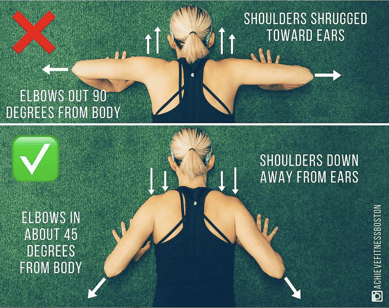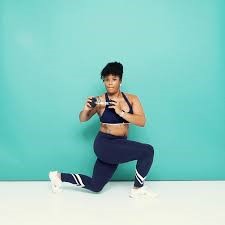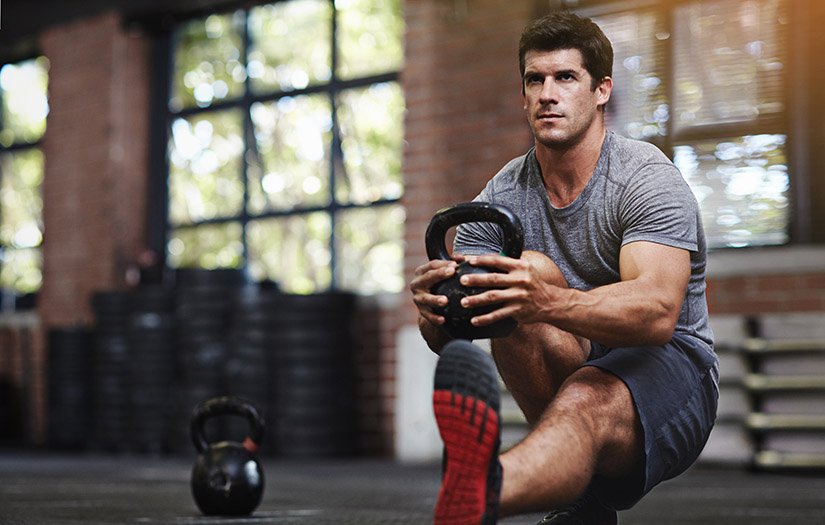By KINSEY MAHAFFEY
Functional training has been a popular training term for decades, and you’ve likely seen the term used recently in gym advertisements, fitness magazines, and social media videos. Unfortunately, sometimes in the fitness industry, a term meant to describe a type of workout becomes trendy and used a little bit too broadly.
HIIT training workouts and functional training are good examples of these. These are more than just marketing terms, though.
When it comes to practical training, it’s a legitimate type of training that can be beneficial for you if you want to move better, improve your fitness, and improve your body composition in the process.
If you are interested in applying this knowledge on a professional basis, check out all of the unique fitness careers you can get involved with!
WHAT IS FUNCTIONAL TRAINING?
Functional training is a type of training that focuses on movements that help you function better in your everyday life. For example, a deadlift can help you train to pick up a heavy Amazon delivery box off of your porch without pulling a muscle in your back.
While this is just one example, our bodies were designed to move in different ways categorized into human movement patterns. We’re made to push and pull with our upper body, hinge at the hips, bend into a squat, lunge or step up, and rotate.
The purpose of training in each of these movements is to keep muscles functioning as they were designed. Functional training typically uses compound movements, meaning you bend at multiple joints and recruit several muscle groups to achieve the movement.
If you think about how you move throughout the day, you might notice that rarely do you just bend one joint in one plane of motion to accomplish any movement.
Many of us don’t utilize each of the movement mentioned above patterns daily, especially if we’re chained to a desk. This makes it vitally important to train these movements intentionally. As they say: if you don’t use it, you’ll lose it.
IS IT THE SAME THING AS CROSSFIT?
Many fitness franchises include functional training movements alongside other types of training. That’s one of the reasons it can be hard to discern what functional training is. CrossFit workouts do include using some of the functional movements previously mentioned.
CrossFit and functional training are not synonymous, however. CrossFit is a sport and requires skilled movements outside of functional training patterns to participate.
FUNCTIONAL TRAINING WORKOUTS (USING COMPOUND EXERCISES)
Here are beginner, intermediate, and advanced functional training moves that will pack a punch! Before diving into the workout, I always recommend foam rolling and stretching first to prepare you for the workout (Do we have an article to link here?? Maybe a corrective exercise article with example, warm-ups?).
Pick one exercise per category to create a circuit of 5 exercises. Go through each exercise in a row with little to no in-between rest exercises and rest 1 minute between each circuit.
Beginners can perform 12 reps and 1-2 sets, intermediate exercisers can perform 12-15 reps and 2-3 sets, and advanced exercisers can do 15 reps and 3 sets. If you don’t have dumbbells, you can get creative by using what you have readily available. I’ve even had a client put books in a backpack to add weight to some exercises requiring resistance!
PUSH UPS:
BEGINNER: INCLINE PUSH-UPS
- Use an elevated surface like a countertop to perform your push-ups. The lower the surface, the harder it will be.
- Place your hands shoulder width apart on the surface and step your feet back so that you’re on your toes and your body is straight in a plank position. Squeeze your abs and glutes and keep them tight throughout the movement so your hips don’t drop down.
- Lower your chest toward the counter top until your elbows are bent at roughly 90 degrees. Exhale and press back up to the starting position.
- At the bottom of the push-up, your elbows should be about 45-degrees away from your body, not straight out to the sides.

INTERMEDIATE: PUSH-UPS ON THE FLOOR
- Perform the push-ups as described above, only this time on the floor!
Advanced: Push-up to rotation
- Perform the push-up as described above, either on an elevated surface or on the floor (the floor is the hardest version).
- When you press back up to your starting position, reach one arm straight up toward the ceiling and rotate your body until your arms are straight and stacked. Your body should resemble a “T”.
- Alternate the direction that you rotate with each push-up. One rotation per push-up.

ROWS:
BEGINNER: BENT OVER ROW
- Stand with your feet hip width apart, holding a weight (dumbbells, a sandbag, a plate, etc.) in front of you.
- Bend your knees and hinge at the hips to get your back as close to parallel to the ground as you can. Keep your abs tight.
- Exhale as you bend your elbows and pull the weight straight up toward your body. Keep your elbows close to your body and your gaze toward the floor.
- Squeeze your shoulder blades together at the top of the movement, and then return to the starting position.
INTERMEDIATE: SINGLE LEG BENT OVER ROW
- The row movement is the same as described above, but the stance is more challenging.
- Hinge forward as you did in the beginner version, and then lift one leg to balance while you row.
- You can perform half of the reps on one leg, and then switch legs.
ADVANCED: RENEGADE ROW
This move is best performed with dumbbells.
- Place two dumbbells shoulder width apart on the ground and grasp the handles as you get into a plank position. Shoulders over the wrists, feet hip width apart, and body in a straight line.
- Squeeze your abs and glutes tight as you row one of your elbows up until your wrist is next to your ribcage. Keep your elbow in close to your body and keep your hips level.
- Return the weight to the ground and switch sides.
- If you need to, you can keep one hand on the ground as you row the dumbbell up with the other (this can be easier on the hands).
SQUATS:
BEGINNER: GOBLET SQUAT
- Hold a weight up at chest height and pull it in close to your body by squeezing your shoulder blades together.
- Stand with your feet hip to shoulder width apart.
- Sit your hips back into a squat (like you’re sitting in a chair). Go as low as you can without losing neutral spine, aiming for thighs parallel to the ground as a good depth.
- Squeeze your glutes and return to a tall standing position.
INTERMEDIATE: DUMBBELL SQUAT
- Same squat, different way to hold the weight.
- Hold dumbbells on each side of your body and perform the squat as described above, keeping the dumbbells down.
- Keep your chest lifted and spine neutral during the squat so that from a side view your shins and back are parallel.
ADVANCED: FRONT SQUAT TO OVERHEAD PRESS
- Hold the dumbbells up so that they rest on your shoulders.
- Sit down into a squat and keep your core tight.
- Squeeze your glutes and abs as you stand and press the weights straight overhead.
- Return the weights to your shoulders and repeat the movement.
HIP HINGE:
BEGINNER: BRIDGE
- Lay on the ground with your feet hip width apart and knees bent. Your arms should be relaxed at your sides with your palms up.
- Press through your heels and squeeze the glutes as you lift the hips off the ground.
- Keep tension in the glutes as you lower the hips to the ground and repeat the movement.
INTERMEDIATE: ROMANIAN DEADLIFT
- Hold a weight in front of you (sandbag, barbell, dumbbells, kettlebell(s)). Keep the weight close to your legs during the entire movement.
- Keep your back flat as you hinge at the hips to lower the weight. You can bend your knees slightly, also.
- Hinge as far as you can keeping your back nice and flat. You should feel a stretch in the hamstrings as you hinge forward.
- Squeeze your glutes as you return to the starting position.
ADVANCED: SINGLE LEG ROMANIAN DEADLIFT
- Same movement as the Romanian deadlift, but performed on one leg.
- Keep your hips parallel to the ground as you hinge forward.
LUNGES:
BEGINNER: WALKING LUNGE
- With or without weights, take a step that’s slightly longer than your normal step forward and bend both knees to lower into a lunge.
- Keep your weight in the front leg and let your back heel come up off of the ground.
- Push through the front foot to stand and then take a step forward with the other leg.
- You will travel forward during this movement.
INTERMEDIATE: LATERAL LUNGE
- Stand with feet hip width apart, with or without weights.
- Take a step to the side and bend the knee of the lunging leg only, keeping the other leg straight.
- Sit your hips straight back and keep both toes pointed straight ahead.
- Push off of the lunging leg to return to where you started.
ADVANCED: CURTSY LUNGE WITH ROTATION
- Hold a medicine ball, kettlebell, dumbbell, or sandbag in front of you.
- Cross one leg behind you into a lunge that resembles a curtsy, hence the name.
- When you’ve lowered into the lunge, rotate your upper body toward the front leg.
- Rotate back to the front and stand. You can alternate sides, or complete all on one side before switching.

WHAT IS THE DIFFERENCE BETWEEN FUNCTIONAL AND STRENGTH TRAINING?
Functional training emphasizes multi-joint movements that mimic everyday movement patterns. In contrast, strength training can utilize isolated movements to target specific muscle groups or fixed machines to guide the exerciser in a particular range of motion.
A body-builder might gravitate more toward traditional strength training to build muscle in specific areas of their body to meet their aesthetic goals. For example, they’re more likely to have a split exercise routine where they target chest and triceps only one day, and the next, they focus on glutes and hamstrings. In functional training, you’ll typically do a full-body workout each time that you train.
WHAT ARE THE BENEFITS OF FUNCTIONAL TRAINING?
#1 IMPROVED HEALTHY MOVEMENT
Intentionally training in each movement pattern that your body was designed to use will help to keep you from creating muscle imbalances that can result in pain, tightness, and poor movement patterns.
#2 DAILY TASKS GET EASIER
Bending over to pick things up, climbing stairs, pulling open unreasonably heavy doors (seriously, why do they do that to us?), picking up squirming toddlers, putting your suitcase in the overhead storage on a plane, and all of your other daily tasks will no longer challenge you physically like they used to. Functional training will prepare you for each of these and more!
#3 REDUCED RISK OF INJURY
As you practice good movement patterns, you’ll realize that you use that same good form to perform similar tasks outside of the gym. This will lead to fewer injuries from poor movement.
#4 NO FANCY EQUIPMENT REQUIRED
You can often just use your bodyweight or grab household objects to add resistance. It can help to have a sandbag or dumbbells, but they’re not necessary. That makes this workout fantastic to do on-the-go!
#5 INCREASED STRENGTH AND OVERALL FITNESS
When you exercise regularly, you’re bound to get stronger, have better endurance, and improve your overall fitness. Go figure!
#6 WEIGHT LOSS
Functional training is great for weight loss since it uses compound movements. This means that you’ll burn more calories in one single exercise than you would doing just a single joint exercise. Winning!
HOW OFTEN SHOULD YOU DO FUNCTIONAL TRAINING?
Like any workout routine, rest and recovery are essential in helping you see your desired results. In addition, the intensity of the workout will determine how many days/week you train. Because functional training workouts are often full-body workouts, it’s a good idea to take a day off between training sessions.
Training at least two days per week is necessary for muscle and bone health, but you can train this way up to 4 days/week if your body recovers well and you feel energized each time you workout.
Functional training is a fantastic way to stay fit, healthy, and strong for everyday function!
THE AUTHOR

KINSEY MAHAFFEY
Kinsey Mahaffey, MPH, is a Houston-based fitness educator, personal trainer and health coach who developed her commitment to lifelong fitness while playing Division I volleyball. She’s passionate about helping others cultivate a healthy lifestyle and enjoys educating other fitness professionals who share this vision. She’s a Master Instructor and Master Trainer for NASM.

